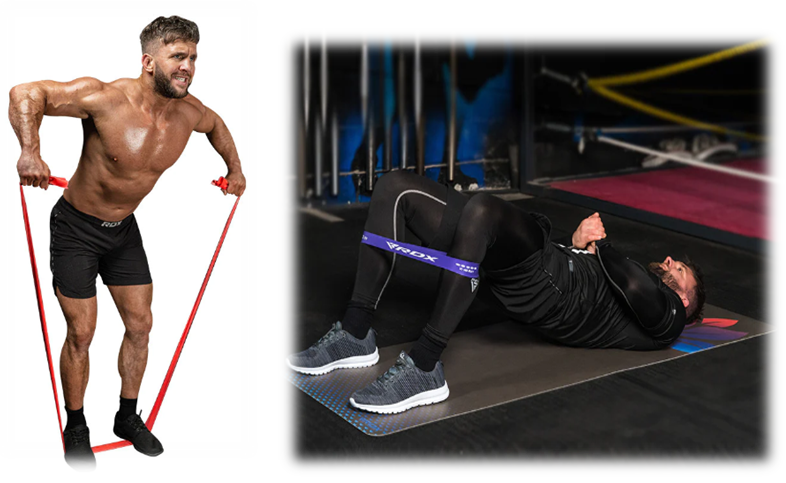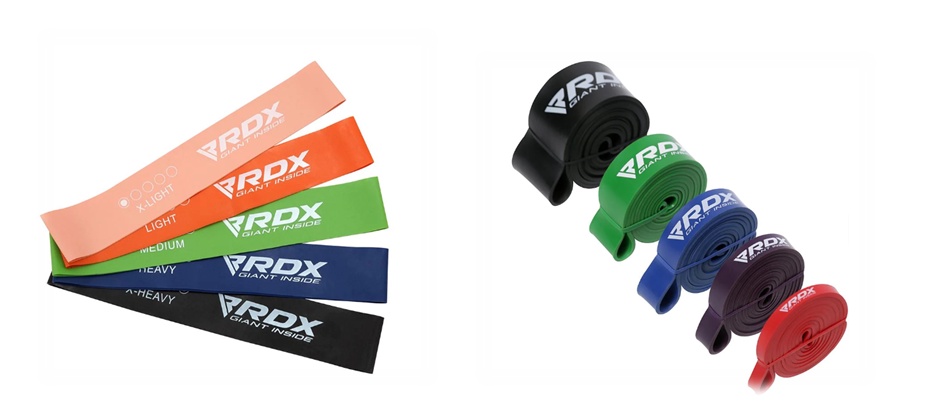Welcome to the dynamic realm of fitness, where innovation and versatility converge to elevate your exercise experience. In this comprehensive guide, we delve into the transformative power of resistance bands and uncover the myriad benefits they offer in sculpting a stronger, leaner, and healthier physique.
Understanding Resistance Bands:
Resistance bands, also known as exercise bands or workout bands, are flexible bands made of elastic material that provide resistance when stretched. They come in various shapes, sizes, and resistance levels, offering a customizable workout experience for users of all fitness levels.
Types of Resistance Bands:
Resistance bands come in various types, each designed to serve specific purposes and cater to different fitness levels. Here's a detailed overview of the most common types:
- Loop Bands:
- Description:
Loop bands, also known as mini bands or booty bands, are continuous loops of elastic material without handles.
- Usage:
These bands are primarily used for lower body exercises such as squats, lunges, glutei bridges, and leg lifts.
- Variety:
Available in different resistance levels ranging from light to heavy, making them suitable for beginners to advanced users.
- Versatility:
Loop bands can also be used for upper body and core exercises by wrapping them around the arms or torso.
- Tube Bands:
- Description:
Tube bands consist of a hollow tube with handles on either end, typically made of durable rubber or latex.
- Usage:
These bands are versatile and can be used for a wide range of exercises, including upper body workouts like bicep curls, shoulder presses, chest flies, and rows.
- Adjustability:
Tube bands often come with interchangeable resistance tubes or detachable handles, allowing users to adjust the resistance level according to their strength and fitness goals.
- Mobility:
The handles offer a secure grip and allow for smooth movement through various ranges of motion, making them ideal for dynamic exercises.
- Figure-8 Bands:
- Description:
Figure-8 bands are shaped like the number 8, with handles on both ends for easy gripping.
- Usage:
These bands offer stability and control, making them suitable for both upper and lower body exercises.
- Strength Training:
Figure-8 bands can be used for exercises such as chest presses, bicep curls, lateral raises, squats, and lunges.
- Compact Design:
The compact design of figure-8 bands makes them travel-friendly and convenient for home workouts or on-the-go fitness routines.
- Resistance Band Sets:
- Description:
Resistance band sets typically include a variety of bands with different resistance levels, along with accessories such as handles, ankle straps, and door anchors.
- Versatility:
These sets offer versatility and flexibility, allowing users to customize their workouts by combining bands of varying resistance levels.
- Full-Body Workouts:
With multiple bands to choose from, users can target different muscle groups and perform a wide range of exercises for a comprehensive full-body workout.
- Progressive Overload:
Resistance bands sets are ideal for progressive overload training, allowing users to gradually increase the resistance as they get stronger and fitter.

- Flat Bands:
- Description:
Flat bands are wide strips of elastic material without handles, offering a smooth and comfortable grip during exercises.
- Functionality:
These bands are versatile and can be used for various upper and lower body exercises, including arm curls, leg lifts, chest presses, and lateral walks.
- Physical Therapy:
Flat bands are commonly used in physical therapy and rehabilitation programs to improve mobility, strength, and flexibility in patients recovering from injuries or surgeries.
- User-Friendly:
Flat bands are beginner-friendly and easy to use, making them suitable for individuals of all ages and fitness levels.
- Fabric Resistance Bands:
- Description:
Fabric resistance bands are made of durable fabric material with non-slip grips, providing added comfort and stability during workouts.
- Gentle Resistance:
These bands offer gentle resistance and are ideal for individuals with sensitive skin or latex allergies.
- Non-Roll Design:
Fabric bands feature a non-roll design, preventing them from slipping or rolling up during exercises, ensuring a seamless workout experience.
- Enhanced Durability:
The fabric construction of these bands enhances durability and longevity, making them suitable for regular use in home gyms or fitness studios.
Benefits of Using Resistance Bands:
- Portability and Convenience:
- Lightweight and compact, making them perfect for home workouts, travel, or on-the-go fitness routines.
- Easily storable in a gym bag, suitcase, or drawer, allowing for quick and convenient access anytime, anywhere.
- Versatility and Adaptability:
- Suitable for a wide range of exercises targeting various muscle groups, including arms, legs, chest, back, and core.
- Adjustable resistance levels accommodate beginners and advanced users alike, making them suitable for progressive overload and muscle growth.
- Joint-Friendly Workouts:
- Provide a low-impact alternative to traditional weightlifting, reducing strain on joints and minimizing the risk of injury.
- Ideal for rehabilitation exercises and recovery workouts, promoting mobility and flexibility without compromising safety.
- Functional Strength Development:
- Mimic natural movement patterns and engage stabilizing muscles, improving functional strength and enhancing overall athleticism.
- Facilitate compound movements and dynamic exercises that translate to real-life activities and sports performance.
Incorporating Resistance Bands into Your Fitness Routine:
- Dynamic Stretching:
Perform dynamic stretches such as leg swings, arm circles, and torso twists to increase blood flow and prepare the muscles for exercise.
- Activation Drills:
Activate key muscle groups with resistance band exercises like clamshells, lateral walks, and shoulder rotations to improve muscle engagement and prevent injury.
Strength Training Workouts:
- Upper Body Exercises:
Target the chest, back, shoulders, and arms with exercises like bicep curls, triceps extensions, rows, and chest presses using tube bands or figure-8 bands.
- Lower Body Exercises:
Strengthen the legs, gluts, and hips with squats, lunges, deadlights, and hip thrusts using loop bands or tube bands.
- Core Strengthening:
Engage the core muscles with exercises like woodchoppers, Russian twists, and plank variations, incorporating resistance bands for added challenge and resistance.
Cool Down and Recovery:
- Static Stretching:
Conclude your workout with static stretches to lengthen and relax the muscles, promoting flexibility and reducing muscle soreness.
- Foam Rolling:
Use a foam roller to massage and release tension in the muscles, enhancing recovery and reducing the risk of delayed onset muscle soreness (DOMS).
Conclusion:
resistance bands are versatile, effective, and accessible fitness tools that offer endless possibilities for strength training, rehabilitation, and overall fitness. Whether you're a beginner looking to kick-start your fitness journey or an experienced athlete seeking to enhance your performance, incorporating resistance bands into your routine can unlock a world of benefits and propel you closer to your health and wellness goals.


No comments yet